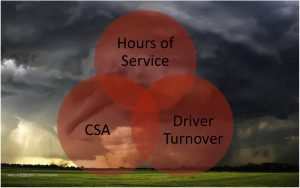The new Hours of Service regulations, which went into effect July 1, 2013, might well be the “Obamacare” of the trucking industry, with yet another challenge issued last Thursday when U.S. Reps. Richard Hanna (R-NY), Tom Rice (R-SC) and Mike Michaud (D-ME) introduced the TRUE Safety Act. The bill specifically targets the 34-hour restart rule, which is the most controversial part of the new HOS regulations, much like the individual mandate is for Obamacare. Here are some highlights of the TRUE Safety Act:
- Truckers would abide by the 34-hour restart rules that were in place before July 1, 2013.
- The Government Accountability Office (GAO) would be required to conduct an independent assessment of the methodology FMCSA used to come up with the new 34-hour restart rule.
- The new 34-hour restart rule could not be re-implemented until six months after GAO submits its assessment to Congress.
According to Representative Rice, “Congress required the FMSCA to complete a comprehensive study before imposing new hours of service standards on our truckers. Instead, the agency has abused its authority and is requiring truckers to comply with one of the most stringent parts of its regulation prior to receiving their study’s findings. This legislation will rein in FMSCA and postpone the new un-tested hours of service regulation until its study is complete and require an additional study to ensure that our truckers are not being overregulated.”
Until recently, I hadn’t heard much from shippers, carriers, or 3PLs about any significant impact to operations resulting from the new rules. But that’s starting to change. Here are some comments issued in recent weeks by Schneider National and Werner Enterprises related to Hours of Service.
From a press release issued by Schneider National on October 24, 2013:
Since the new HOS implementation, Schneider has realized a 3.1 percent drop in productivity on solo shipments and a 4.3 percent decline on team shipments [emphasis mine]. The results are similar to Schneider’s forecasted 3–4 percent, which was based on predictive modeling and presented as testimony to the Federal Motor Carrier Safety Administration in February 2011.
“The Hours of Service changes could not have come at a worse time,” said Dave Geyer, senior vice president/general manager of Schneider’s Van Truckload division. “We now need more drivers to do the same amount of work, but regulations, economic conditions and demographics are working against us in terms of recruiting new drivers. Those who do answer the call deserve an attractive wage and good benefits, but we’re being restricted in the number of miles we can give them and the ongoing challenges that come with sharply rising operating costs.”
And from Werner Enterprises’ Q32013 financial results press release:
The Federal Motor Carrier Safety Administration (“FMCSA”) published final driver hours of service (“HOS”) rules in December 2011, which became effective July 1, 2013. Among the changes were more restrictive requirements covering driver use of the 34-hour restart rule and a new mandatory 30-minute rest period after 8 hours on duty. The Company modified and tested its electronic HOS system and began dispatching drivers under the revised HOS rules effective July 1. As expected, the Company believes that these hours of service changes negatively impacted miles per truck by two to three percent [emphasis mine].
I’m speaking tomorrow about Hours of Service at the CONECT 12th Annual Northeast Cargo Symposium, so I won’t steal any more of my thunder today. But here’s one of the key points I plan to communicate to the audience tomorrow: do not view Hours of Service as an isolated issue in the trucking industry; it’s just one factor, along with CSA, driver shortage, and others, that are coming together to create a capacity crunch “perfect storm,” similar to (or perhaps worse than) the one we experienced in 2004. The only missing factor is a strong growing economy, which is why we find ourselves today in the calm before the storm. What are you doing to prepare before the winds pick up and you’re caught in the storm path?

For related commentary, see What is the Future of Truckload Transportation?











